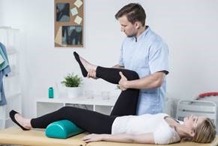In this newsletter, we are discussing the prevention of knee pain.
Knee injuries are often the result of blunt trauma or repetitive movements that include playing certain sports, frequently bending the knee, or repeatedly moving heavy items.
The risk of suffering from a knee injury also increases with age. Although certain factors that contribute to knee problems cannot be avoided, such as enduring a traumatic knee injury, job-related physical duties, or aging, there are several ways to prevent unwarranted knee damage.
 If you have previously experienced a knee injury or you want to avoid injuring your knee, some people will benefit from avoiding impact-oriented exercises such as running, or explosive sports like soccer or tennis. If impact activities are causing you pain, alternatives to consider include swimming, an elliptical machine, or pole walking. Many people can regularly engage in explosive or impact sports without pain, but the nature of the sport itself increases their risk for injury. To reduce your risk of injury, regardless of the activity, it is essential that you dynamically warm up the muscles before exercising in a way that prepares your leg muscles for your sport or activity of choice.
If you have previously experienced a knee injury or you want to avoid injuring your knee, some people will benefit from avoiding impact-oriented exercises such as running, or explosive sports like soccer or tennis. If impact activities are causing you pain, alternatives to consider include swimming, an elliptical machine, or pole walking. Many people can regularly engage in explosive or impact sports without pain, but the nature of the sport itself increases their risk for injury. To reduce your risk of injury, regardless of the activity, it is essential that you dynamically warm up the muscles before exercising in a way that prepares your leg muscles for your sport or activity of choice.
A physiotherapist can demonstrate beneficial activity-specific warm up exercises and cool down stretches, and make sure you are performing the techniques correctly before you begin. For individuals who like to engage in weight training, working with a physiotherapist is one of the keys to preventing knees injuries, as a physiotherapist has expertise regarding the optimal way to lift weights without causing knee pain. In addition to safely engaging in physical activity, it is important to maintain an optimal weight, as extra body weight (e.g., obesity) places excess stress on the knees and increases the risk of knee joint wear and tear, or injury. Wearing shoes designed for your activity will help you maintain the right balance and leg alignment and ensure you can grip or slide over the surface you play on, depending on what is optimal. It may be beneficial to get fitted with an athletic shoe that is designed to absorb some of the impact of physical activity; thereby relieving stress on the knees.
Individuals who are recovering from a knee injury can greatly benefit from speaking with a physiotherapist who can develop an exercise regime that will help prevent the occurrence of future injuries. More specifically, the physiotherapists at In Balance Physiotherapy will perform a comprehensive assessment in order to examine all the potential factors contributing to your knee pain or injury such as alignment, walking pattern, muscle length and strength, and technique. They can then establish a physiotherapy routine specific to your needs that supports recovery and decreases the chances of experiencing knee pain. It may be tempting to decrease your level of physical activity to avoid further injury, but a lack of exercise can actually cause muscle weakness that increases the risk of knee problems. Working closely with a physiotherapist is a great way to remain active without the fear of making an improper movement that may cause knee damage.
A physiotherapist can also discuss or try out popular supports such as tape, knee braces, or shoe inserts aimed at reducing knee pain, to see if they are likely to be of benefit to you. Call In Balance Physiotherapy today to meet trained professionals who can provide you with the services you need to enjoy an enhanced quality of life while avoiding unnecessary knee injuries.
References
- Toivanen AT, Heliövaara M, Impivaara O, Arokoski JP, Knekt P, Lauren H, Kröger H. Obesity, physically demanding work and traumatic knee injury are major risk factors for knee osteoarthritis--a population-based study with a follow-up of 22 years. Rheumatology (Oxford). 2010; 49(2):308-14.
- Ruan M, Zhang Q, Wu X. Acute Effects of Static Stretching of Hamstring on Performance and Anterior Cruciate Ligament Injury Risk During Stop-Jump and Cutting Tasks in Female Athletes. J Strength Cond Res. 2017; 31(5):1241-1250.
- Farquharson C, Greig M. Temporal pattern of kinesiology tape efficacy on hamstring extensibility. Int J Sports Phys Ther. 2015 Dec;10(7):984-91.
- Wannop JW, Luo G, Stefanyshyn DJ. Footwear traction and lower extremity noncontact injury. Med Sci Sports Exerc. 2013; 45(11):2137-43.
- Hosp S, Folie R, Csapo R, Hasler M, Nachbauer W. Eccentric Exercise, Kinesiology Tape, and Balance in Healthy Men. J Athl Train. 2017; doi: 10.4085/1062-6050-52.3.11, in press.









